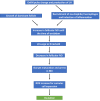A review of nitric oxide and oxidative stress in typical ovulatory women and in the pathogenesis of ovulatory dysfunction in PCOS
- PMID: 37996893
- PMCID: PMC10666387
- DOI: 10.1186/s12958-023-01159-6
A review of nitric oxide and oxidative stress in typical ovulatory women and in the pathogenesis of ovulatory dysfunction in PCOS
Abstract
Polycystic ovary syndrome (PCOS) is a heterogeneous functional endocrine disorder associated with a low-grade, chronic inflammatory state. Patients with PCOS present an increased risk of metabolic comorbidities and often menstrual dysregulation and infertility due to anovulation and/or poor oocyte quality. Multiple mechanisms including oxidative stress and low-grade inflammation are believed to be responsible for oocyte deterioration; however, the influence of nitric oxide (NO) insufficiency in oocyte quality and ovulatory dysfunction in PCOS is still a matter for debate. Higher production of superoxide (O2•-) mediated DNA damage and impaired antioxidant defense have been implicated as contributory factors for the development of PCOS, with reported alteration in superoxide dismutase (SOD) function, an imbalanced zinc/copper ratio, and increased catalase activity. These events may result in decreased hydrogen peroxide (H2O2) accumulation with increased lipid peroxidation events. A decrease in NO, potentially due to increased activity of NO synthase (NOS) inhibitors such as asymmetric dimethylarginine (ADMA), and imbalance in the distribution of reactive oxygen species (ROS), such as decreased H2O2 and increased O2•-, may offset the physiological processes surrounding follicular development, oocyte maturation, and ovulation contributing to the reproductive dysfunction in patients with PCOS. Thus, this proposal aims to evaluate the specific roles of NO, oxidative stress, ROS, and enzymatic and nonenzymatic elements in the pathogenesis of PCOS ovarian dysfunction, including oligo- anovulation and oocyte quality, with the intent to inspire better application of therapeutic options. The authors believe more consideration into the specific roles of oxidative stress, ROS, and enzymatic and nonenzymatic elements may allow for a more thorough understanding of PCOS. Future efforts elaborating on the role of NO in the preoptic nucleus to determine its influence on GnRH firing and follicle-stimulating hormone/Luteinizing hormone (FSH/LH) production with ovulation would be of benefit in PCOS. Consequently, treatment with an ADMA inhibitor or NO donor may prove beneficial to PCOS patients experiencing reproductive dysfunction and infertility.
Keywords: Abnormal nitric oxide pulsatility; Ano and oligo-anovulation; Oxidative stress; Polycystic ovary syndrome.
© 2023. The Author(s).
Conflict of interest statement
The authors declare no competing interests.
Figures


References
-
- Knochenhauer ES, et al. Prevalence of the polycystic ovary syndrome in unselected black and white women of the southeastern United States: a prospective study. J Clin Endocrinol Metab. 1998;83(9):3078–82. - PubMed
-
- Asuncion M, et al. A prospective study of the prevalence of the polycystic ovary syndrome in unselected caucasian women from Spain. J Clin Endocrinol Metab. 2000;85(7):2434–8. - PubMed
Publication types
MeSH terms
Substances
LinkOut - more resources
Full Text Sources
Medical

